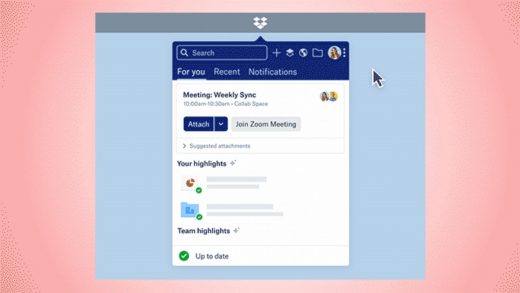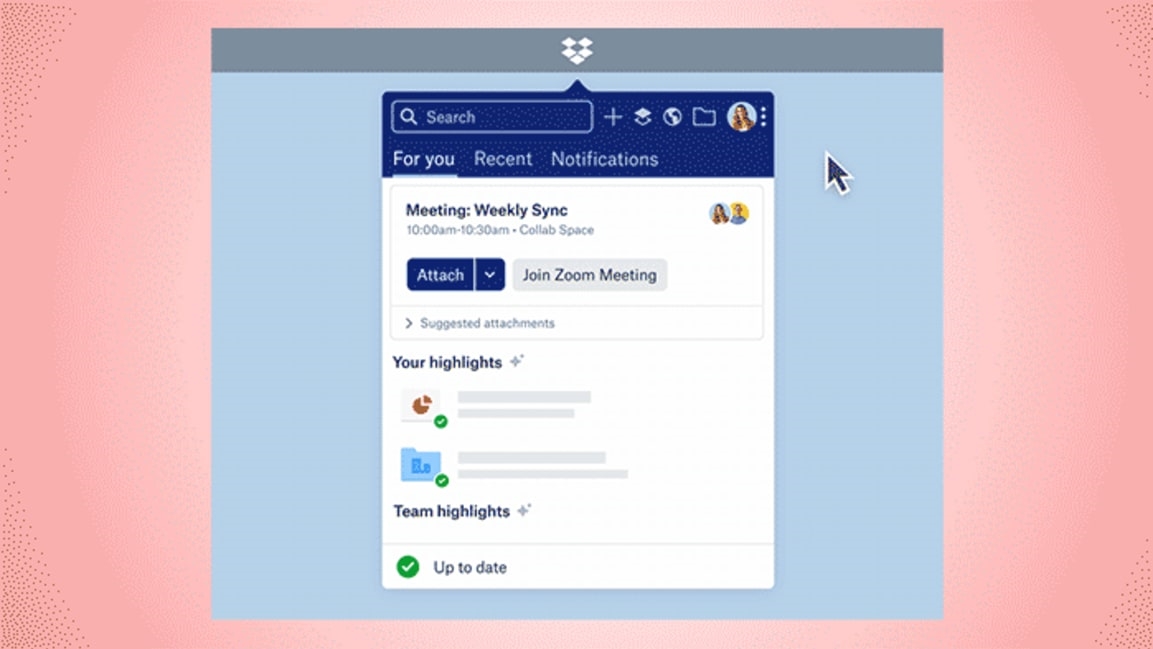Dropbox just doubled down on collaboration (again)
Dropbox is holding a conference in San Francisco today called “Work in Progress.” It includes some sessions on the general topic of staying happy and productive in a world with an ever-increasing number of distractions, culminating in an off-the-record conversation this afternoon with former First Lady Michelle Obama. But the event’s keynote this morning, hosted by Dropbox CEO Drew Houston, was all about the service itself—and primarily about a new core experience the company is calling Dropbox Spaces.
Though Spaces is still about managing and sharing content, it goes well beyond Dropbox’s familiar file-folder metaphor with features such as the ability to search for images that depict specific items (such as “clothing”); integrations with other tools such as calendars, Trello, and Dropbox’s own Paper); more ambitious previews for file formats such as AutoCAD; and a whole lot more. The service also uses machine learning to highlight activity updates from coworkers which it thinks are most likely to be of interest.
Dropbox Spaces builds on the sweeping update Dropbox announced last June, which introduced a Dropbox app for Windows and macOS for the first time, thereby making the service less dependent on the user interfaces provided by the operating systems themselves. Rather than one big bang, in other words, the company reinvented its service in two medium-size bangs over the course of several months. The goal, says CTO Quentin Clark, was to acclimate users to the less folder-centric experience before inundating them with too much new stuff all at once. “We had to get the baseline part of the journey going,” he says. “Before I can give you the cherry ice cream, I need to make sure the vanilla is good.”

[Image: courtesy of Dropbox]
Whetting customers’ appetite for what was to come also let Dropbox make some changes on the fly, as it did when early users told the company that a breadcrumb trail showing a file’s location in the folder hierarchy should be at the top, not the bottom. “That was the tiniest thing ever, but it’s an example of the kind of qualitative feedback we got from our users,” says Clark.
Not everyone wants to see Dropbox move beyond quietly and reliably syncing files in the background. Back in June, after using the new version for myself and finding the additional functionality easy enough to ignore, I was surprised by the passion with which some people rejected the new vision; here’s Boing Boing’s Rob Beschizza on the subject. Clark says that Dropbox takes such unhappy campers and their complaints seriously. “It’s incumbent upon us to listen to that and make sure they’re still being taken care of,” he told me, adding that Dropbox’s goal is to let those who liked the old, behind-the-scenes version of the service continue to use it the way they always did.
Meanwhile, the Dropbox users who should, in theory, be receptive to a version of the service that feels more like a collaboration hub need to deal with the fact that other workplace services that never competed with Dropbox in the past are pursuing strategies that look at least vaguely similar. Do you live in Slack and dip into Dropbox, or vice versa? Clark says that as Dropbox has pulled in new types of content—as it did in April with a slick integration with Google’s G Suite—it’s increased users’ engagement with other services rather than leaving them walled off within Dropbox’s world.
ISG principal analyst Blair Hanley Frank, a fellow attendee of Dropbox’s conference, told me that the fierce competition for knowledge workers’ attention will lead to a variety of companies encroaching on each other’s territory, though in the long run they all need to adjust to a world in which different workplaces use different combinations of tools in different ways. “It’ll take a few years for this to shake out,” he says. “And until then, it’s going to be utter chaos.”
(33)



